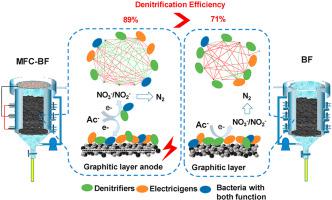Environmental Research ( IF 7.7 ) Pub Date : 2020-10-14 , DOI: 10.1016/j.envres.2020.110331 Zhi-Ling Li , Zhong-Li Zhu , Xiao-Qiu Lin , Fan Chen , Xu Li , Bin Liang , Cong Huang , Yuan-Ming Zhang , Kai Sun , An-Nan Zhou , Ai-Jie Wang

|
The excess organic carbon is often added to meet denitrification requirements during municipal wastewater treatment, resulting in the carbon waste and increased risk of secondary pollution. In this study, microbial fuel cell (MFC) was coupled with an up-flow denitrification biofilter (BF), and the long-term performances of denitrification and power output were investigated under the different carbon source concentration. With sodium acetate (NaAc) of 600 mg/L and 300 mg/L, the favorable denitrification efficiencies were obtained (98.60%) and the stable current output was maintained (0.44 mA∼0.48 mA). By supplying NaAc of 150 mg/L, the high denitrification efficiency remained in a high range (89.31%) and the current output maintained at 0.12 mA, while, the denitrification efficiency dropped to 71.34% without coupling MFC. Electron balance analysis indicated that both nitrate removal and electron recovery efficiencies were higher in MFC-BF than that in BF, verifying the improved denitrification and carbon utilization performance. Coupling MFC significantly altered the bacterial community structure and composition, and while, the diversified abundance and distribution of bacterial genera were observed at the different locations. Compared with BF, the more exoelectrogenic genera (Desulfobacterium, Trichococcus) and genera holding both denitrifying and electrogenic functions (Dechloromonas, Geobacter) were found dominated in MFC-BF. Instead, the dominating genera in BF were Dechloromonas, Desulfomicrobium, Acidovorax and etc. By coupling MFC, the more complex and diversified network and the closer interaction relationships between the dominant potential functional genera were found. The study provides a feasible approach to effectively improve the denitrification efficiency and organic carbon recovery for deep denitrification process.
中文翻译:

用于深度反硝化和动力回收的微生物燃料电池-上流式生物滤池耦合系统:效率,细菌演替和相互作用
通常会添加过量的有机碳以满足市政废水处理过程中的反硝化要求,从而导致碳浪费并增加二次污染的风险。在这项研究中,微生物燃料电池(MFC)与上流反硝化生物滤池(BF)结合使用,并研究了在不同碳源浓度下的反硝化和动力输出的长期性能。乙酸钠(NaAc)分别为600 mg / L和300 mg / L时,可获得良好的反硝化效率(98.60%),并保持稳定的电流输出(0.44 mA〜0.48 mA)。通过提供150 mg / L的NaAc,高反硝化效率保持在较高的范围(89.31%),电流输出保持在0.12 mA,而在不耦合MFC的情况下,反硝化效率降至71.34%。电子平衡分析表明,MFC-BF的硝酸盐去除率和电子回收效率均高于BF,证明了反硝化和碳利用性能的提高。MFC的耦合显着改变了细菌群落的结构和组成,同时,在不同的位置观察到了细菌属的丰富度和分布。与高炉相比,更多的外生电属(Desulfobacterium,Trichococcus)和属保持两者反硝化和电的功能(脱氯,地杆菌)在MFC-BF发现支配。取而代之的是,高炉中最主要的属是Dechloromonas,Desulfomicrobium,Acidovorax等。通过MFC耦合,发现了更复杂和多样化的网络,以及潜在的潜在功能属之间的联系更紧密。该研究为有效提高深度反硝化过程的反硝化效率和有机碳回收率提供了可行的方法。


















































 京公网安备 11010802027423号
京公网安备 11010802027423号